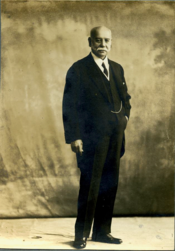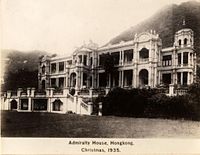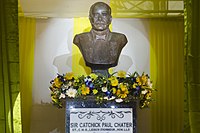Sir Catchick Paul Chater | |
|---|---|
 Sir Paul Chater in 1924 | |
| Senior Unofficial Member of the Executive Council | |
| In office 8 September 1896 – 27 May 1926 | |
| Appointed by | William Robinson |
| Governor | William Robinson Henry Arthur Blake Matthew Nathan Frederick Lugard Francis Henry May Reginald Edward Stubbs Cecil Clementi |
| Succeeded by | Sir Henry Pollock |
| Senior Unofficial Member of the Legislative Council | |
| In office 1 May 1900 – 16 January 1906 | |
| Appointed by | Henry Arthur Blake |
| Governor | Henry Arthur Blake Matthew Nathan |
| Preceded by | Emanuel Raphael Belilios |
| Succeeded by | Sir Kai Ho |
| Personal details | |
| Born | Khachik Pogose Astwachatoor 8 September 1846 Calcutta, India |
| Died | 27 May 1926 (aged 79) British Hong Kong |
| Spouse | Maria Christine Pearson |
| Occupation | Businessman |
| Awards | Order of British Empire, Order of St Michael and St George |
| Paul Chater | |||||||||
|---|---|---|---|---|---|---|---|---|---|
| Traditional Chinese | 遮打 | ||||||||
| |||||||||
Sir Catchick Paul Chater KBE CMG Kt (Armenian: Խաչիկ Փոլ Չաթեր; Chinese: 遮打; 8 September 1846 – 27 May 1926) was a prominent British businessman of Armenian descent in colonial Hong Kong, whose family roots were in Calcutta, India.
Biography
Early life
Chater was born Khachik Pogose Astwachatoorean[1][2] (Armenian: Խաչիկ Պօղոս Աստուածատուրեան) in Calcutta, British India, one of thirteen offspring of Armenian parents, Miriam and Chater Paul Chater. His father was a member of the Indian civil service.
Chater was orphaned at the age of seven, and he gained entry into the La Martiniere College in Calcutta on a scholarship. In 1864,[3] he moved to Hong Kong from Calcutta and lived with the family of his sister Anna and her husband, the Armenian-born Jordan Paul Jordan (1820–1875).[4][5]
Career

In the early days in Hong Kong, he was an assistant at the Bank of Hindustan, China and Japan. Later, with the aid of the Sassoon family, he set up business as an exchange broker, resigned from the bank, and traded gold bullion and land on his own account.[4] He took sea-bed soundings at night in a sampan and was thus instrumental in plotting the reclamation of Victoria Harbour.[4] He is credited with a pivotal role in the colonial government's success in acquiring lands then held by the military, at a cost of two million pounds sterling.[3]
In 1868, he and Sir Hormusjee Naorojee Mody formed brokerage company Chater & Mody, a largely successful business partnership in Hong Kong, although the firm's Hong Kong Milling Company (aka Rennie's Mill) failed in 1908 and resulted in the suicide of Albert Rennie.[4]
In 1886, he helped Patrick Manson establish Dairy Farm, and he entered the Legislative Council that same year, taking the place of F.D. Sassoon.[6] Also in 1886 Chater established Kowloon Wharf and Godown, predecessor of The Wharf (Holdings).[7]
In 1889, he established Hongkong Land with James Johnstone Keswick.[8] Hong Kong Land commenced the land reclamation project under the Praya Reclamation Scheme in 1890. Persuaded by the suggestion of temporary councillor Bendyshe Layton that Hong Kong should have electricity, they secretly acquired an old graveyard in Wan Chai, where they built one of the earliest power stations in the world.[9] In 1890, the Hongkong Electric Company went into production.[10]
Chater was enthusiastic in two sports: He played for the Hong Kong Cricket Club 1st XI, and was a thoroughbred horse racing enthusiast. He reportedly never missed the weekly races at the Happy Valley Racecourse in 60 years.[9] He set up the Chater Stable in Hong Kong in 1872 that won many races at Happy Valley.[11] The Hong Kong Champions & Chater Cup, the Group One third leg of the Hong Kong Triple Crown, is named in his honour.
In 1896, Chater joined government ranks when he was appointed to the Executive Council, and served there until 1926, the year of his death.[6] He was knighted in the 1902 Coronation Honours,[12] receiving the accolade in person from King Edward VII at Buckingham Palace on 24 October that year.[13]
In 1901, Chater constructed a very fine home with imported European marble at 1, Conduit Road, Hong Kong which he named 'Marble Hall'.[14] Therein, he housed his collection of fine porcelain. To commemorate the coronation of King Edward VII in 1902, Chater presented a statue in bronze of the King to Hong Kong, executed by George Edward Wade and unveiled at Statue Square in 1907. In 1904, Chater single-handedly financed the construction of St. Andrew's Church.[3]
Some titles and positions held by Chater:
- Master of the Perseverance Lodge, 1873
- Steward at the Royal Hong Kong Jockey Club
- Chairman of the Board of Stewards of the Royal Hong Kong Jockey Club, 1892–1926
- Senior Justice of the Peace in Hong Kong
- District Grand Master of Hong Kong and South China, 1881–1909
- Director of Dairy Farm Co. Ltd., 1886
- Consul for Siam in Hong Kong
- Treasurer and Chairman of the Queen Victoria Jubilee Committee, 1887
- Member of the Légion d'honneur by the French Government at Tonkin, 1892
- Member of the Public Lighting Committee, 1896
- Member of the Governor's Executive Council, 1896
- Chairman of the Queen Victoria Diamond Jubilee Committee, 1897
- Companion of the Order of St Michael and St George, 1897
- Honorary degree of LL.D. by the University of Hong Kong[15] for services as the Honorary Treasurer, 1923
Philanthropy
In May 1923, Chater, then treasurer of the University of Hong Kong, made a donation of $250,000 to the university at a time critical to its survival.[16]: 69
In 1924/25, Chater made the single biggest donation to any institution or organisation whilst still alive, donating 1.1 million Rupees to his alma mater, the desperately struggling La Martiniere College, thus allowing it to avoid certain closure. To honour his contribution to the school, Sir Paul Chater's name was included in the school prayer.[17]
Legacy


Chater died in 1926, and bequeathed Marble Hall and its entire contents, including his unique collection of porcelain and paintings, to Hong Kong. The remainder of his estate went to the Armenian Church of the Holy Nazareth in Calcutta, which runs a home for Armenian elderly, named The Sir Catchick Paul Chater Home.[4] He was interred at the Hong Kong Cemetery.
Chater's wife lived in Marble Hall as a life tenant until her death in 1935.[14][18] Ownership then passed to the government. It became "Admiralty House" – the official residence of the Naval Commander-in-Chief, and was commandeered by Japanese during their occupation. It accidentally burned down in 1946, and the government buildings occupied the site since its demolition in 1953. Government residences named 'Chater Hall Flats' are today located on the site of Marble Hall.[14]
Chater amassed a large collection of historical pictures and engravings relating to China which he gifted to the colony. The Chater Collection was subject to a work by its curator, James Orange, in 1924, at which time the collection stood at 430 items. Its backbone was the collection of Wyndham Law of the Chinese Maritime Customs Service, and included oil paintings, watercolours, sketches, prints and photographs, most of which are based on landscape scenes of the South China trading ports in the 18th and 19th centuries, and of British activities in China.[3] The Chater Collection was dispersed and largely destroyed during the Japanese occupation, and only 94 pieces (now an important part of the collection of the Hong Kong Museum of Art) are known to have survived.[19]
Chater's nephew (Anna's son) Gregory Paul Jordan was instrumental in developing medical services and education in Hong Kong and in the founding of the University of Hong Kong. He was its second vice-chancellor.[16]: 64
On the occasion of the 171st anniversary of Paul Chater's birth, a bust of Paul Chater was unveiled at the La Martiniere Boys School, Kolkata.[20]
- Chater Garden
- Chater House
- Chater Road[8]
- Catchick Street[8]
- Peking Road was named Chater Street until 1909, when it was renamed to avoid confusion with Chater Road.[21]
See also
References
- ^ Biography: Who Was This Man? CHATER. Liz Chater published 2010
- ^ “This was such a fantastic discovery for me and the first I knew that I had Armenian ancestors in my family”, HETQ online, 29 March 2010
- ^ a b c d James Orange (1924). The Chater Collection: Pictures Relating to China, Hongkong, Macao, 1655–1860.
- ^ a b c d e England, Vaudine (16 December 2007) "Who was this man Chater?", Page 11, South China Morning Post
- ^ Jordan Paul Jordan profile, chrisgrant.eu. Accessed 8 August 2023.
- ^ a b Vaudine England and Elizabeth Sinn, The Quest of Noel Croucher: Hong Kong's Quiet Philanthropist (Hong Kong University Press, 1998)
- ^ Robert Nield (June 2010). The China Coast : Trade and the First Treaty Ports. Joint Pub. ISBN 9789620429873. Retrieved 8 September 2019 – via Google Books.
- ^ a b c Jason Wordie, Land-grabbing titans who changed HK's profit for good Archived 22 May 2011 at the Wayback Machine, 18 April 1999
- ^ a b "The Legacy of Sir Catchick Paul Chater" Archived 8 July 2011 at the Wayback Machine, City Life. Retrieved 28 January 2011
- ^ Wiltshire, Trea. [First published 1987] (republished & reduced 2003). Old Hong Kong – Volume Two. Central, Hong Kong: Text Form Asia books Ltd. Page 11. ISBN Volume One 962-7283-60-6
- ^ Coates, Austin China Races, Oxford University Press (China) (2 February 1984) pp133-140
- ^ "The Coronation Honours". The Times. No. 36804. London. 26 June 1902. p. 5.
- ^ "No. 27494". The London Gazette. 11 November 1902. p. 7165.
- ^ a b c "Marble Hall Gatekeeper's Lodge [1901– ] | Gwulo: Old Hong Kong". gwulo.com. Retrieved 7 July 2019.
- ^ Congregation (1923) – Sir Catchick Paul CHATER, Doctor of Laws Archived 28 September 2011 at the Wayback Machine, University of Hong Kong
- ^ a b Mellor, Bernard (1981). The University of Hong Kong: An Informal History. Hong Kong University Press. ISBN 9789622090231.
- ^ Armenians in India: Mesrovb Seth, P.551
- ^ According to her gravestone, Lady Maria Christine Chater was born 6 May 1879 and died 11 March 1935; but according to her birth certificate she was born 6 May 1874 in Granberga, Heby, Sweden
- ^ Press Release (23 March 2007). "Chater art collection goes on show[permanent dead link]", Hong Kong Museum of Art
- ^ "A friend in need". The Telegraph. India. 9 September 2017. Archived from the original on 9 September 2017. Retrieved 9 September 2017.
- ^ The Hong Kong Government Gazette, 19 March 1909
External links
- Article about Hormusjee Naorojee Mody with Chater & Mody
- Catchick Paul Chater – ongoing family history research by distant relative Liz Chater}
- Documentary on Sir Paul Chater, Henrik Terchonian (2005) Armenian Holy Church of Nazareth, Kolkata
- Sir Catchick Paul Chater Documentary Film – Armenian Church Pilgrimage to Hong Kong 2005 (YouTube video) on YouTube
- 1846 births
- 1926 deaths
- People from British Hong Kong
- Hong Kong people of Armenian descent
- Indian people of Armenian descent
- Jardines (company)
- La Martiniere Calcutta alumni
- Members of the Legislative Council of Hong Kong
- Members of the Executive Council of Hong Kong
- Companions of the Order of St Michael and St George
- Ethnic Armenian businesspeople
- British people of Armenian descent
- Knights Bachelor
- Emigrants from British India
- Hong Kong businesspeople








